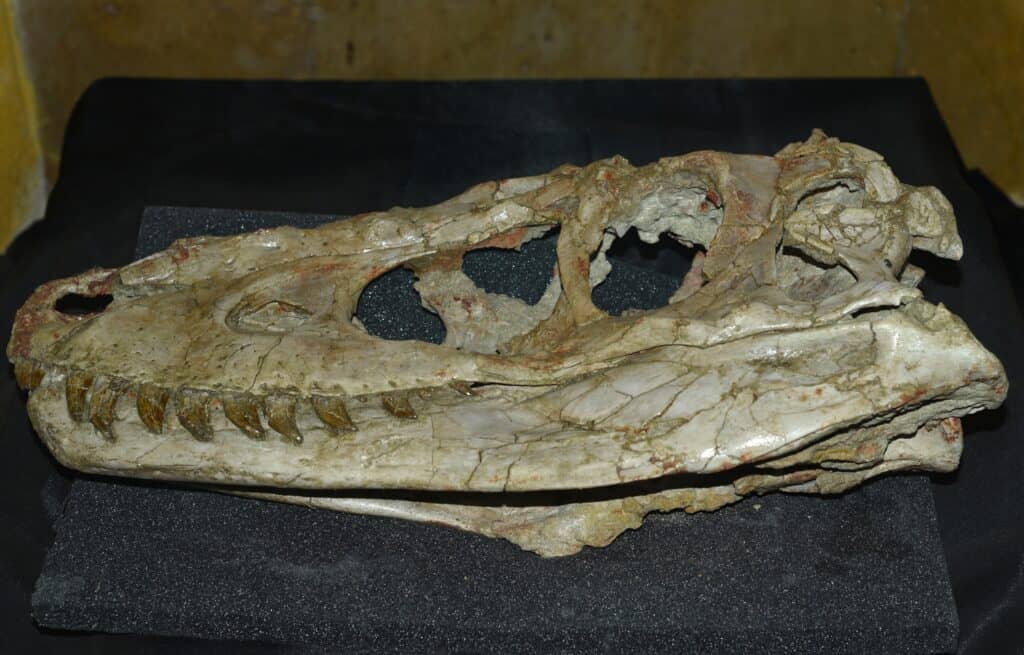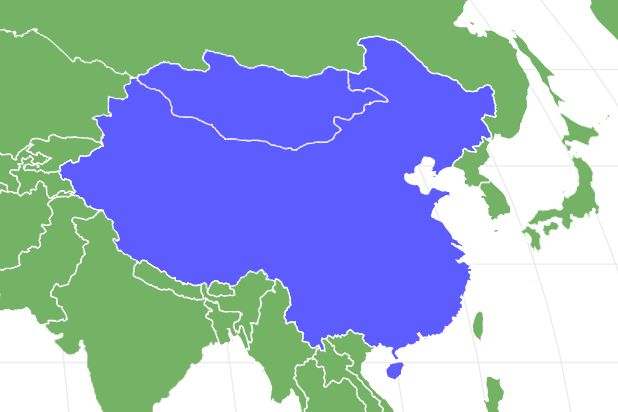Tarbosaurus
Tarbosaurus bataar
Tarbosaurus‘ name “bataar” is a mispelling of the Mongolian word “baatar,” which means “hero.”
Advertisement
Tarbosaurus Scientific Classification
- Kingdom
- Animalia
- Phylum
- Chordata
- Class
- Reptilia
- Order
- Saurischia
- Family
- Tyrannosauridae
- Genus
- Tarbosaurus
- Scientific Name
- Tarbosaurus bataar
Read our Complete Guide to Classification of Animals.
Tarbosaurus Conservation Status
Tarbosaurus Facts
- Prey
- Hadrosaur, Sauropod, Saurolophus
- Name Of Young
- Hatchling
- Group Behavior
- Mainly solitary
- Fun Fact
- Tarbosaurus‘ name “bataar” is a mispelling of the Mongolian word “baatar,” which means “hero.”
- Biggest Threat
- Larger Dinosaurs
- Most Distinctive Feature
- Small arms, slender skull
- Other Name(s)
- Alarming Lizard
- Habitat
- Flood plainlands
- Predators
- Other Tarbosaurus and Therizinosaurus
- Diet
- Carnivore
- Location
- Mongolia, China
View all of the Tarbosaurus images!
The Tarbosaurus bataar, also known as the Alarming Lizard, was found in China and Mongolia. It is native to the continent of Asia and is often mistaken for the Tyrannosaurus. Find out more about this ancient creature, including where it lived, its size, and more!
Description & Size
According to the fossil that was found in East Asia, its physical attributes may be related to that of a Tyrannosaurus, but each are quite distinct. Here is a brief description of its physical characteristics.
- The Tarbosaurus was one of the largest tyrannosaurids. Its length measured up to 32 feet and weighed around 5.6 tons.
- The Tarbosaurus had a huge body with small arms. The arms were so small that they could not even reach their mouths.
- But the dinosaur had two large legs, holding its body up. They were both thick and long, unlike the arms of the Tarbosaurus. They allowed it to move swiftly in an agile manner.
- Each of its arms had two digits with claws, and one digit with no claw. On some Tarbosaurus, however, the third metacarpal with no claw did not even exist.
- They also had scaly skin covering their horizontal body but the scales did not overlap each other.
- The tail of the Tarbosaurus was quite heavy and long in comparison. But it did balance out the structure and weight of the body.
- The skull of the Tarbosaurus was around 4.2 feet long. Its shape was slender near the rear, unlike that of the Tyrannosaurus. Moreover, it did not weigh as much due to numerous openings in the skull and its lightweight structure.
- Tarbosaurus also had a smaller brain in comparison with the large skull
- The eyes of the Tarbosaurus were not as developed nor did they have binocular vision, meaning that the eyes did not face forwards.
- The neck of the Tarbosaurus was S-shaped and was vertical, while its whole body — including the vertebral column — was horizontal.
- More than 58 sharp, large, and knife-shaped teeth were found lining the jaws of the Tarbosaurus. The length of each tooth was around 3.3 cm.
- A ridge is present between the angular bone and the dentary bone which makes it a distinctive feature of the Tarbosaurus.
Diet – What Did Tarbosaurus Eat?
Based on its body structure and the shape of its teeth, the Tarbosaurus was without a doubt, a carnivore. But whether it was a predator or a scavenger is still quite unknown.
The Tarbosaurus had quite a strong bite force. It could crush down bones and be known to carry a force of 8K to 10K pounds. In addition, due to its biting force, it is assumed that it hunted down large dinosaurs like the hadrosaur and sauropods because a lot of their fossils were found with the bite marks of the Tarbosaurus.
But it can also be assumed that this bite force was utilized in crunching down the bones of the dinosaurs.
There are some fossils of the Saurolophus that show the bite marks of the Tarbosaurus. They suggest that the Tarbosaurus was a scavenger. But with the fact that it had a lightweight body, a strong pair of jaws, and an agile motion, it cannot be ignored that it may be a predator. The studies do prefer calling it a predator but nothing can be confirmed as of now.
Habitat – When and Where It Lived?
The Tarbosaurus existed over 83.6 million years ago. It comes from the Maastrichtian Age, the Cretaceous Period, and the Mesozoic Era.
The Tarbosaurus was found mostly in East Asia. Specifically, its fossils have been found in China and Mongolia. But if we take its habitat into account, the area mostly consisted of flood plains where it lived and hunted in the form of packs. Considering the climate of their habitat, they lived in a colder climate.
Behavior
The Tarbosaurus either hunted alone or in groups. Now, whether they were sociable is based on the assumption that they were hungry predators. So, it is probably untrue to say they were sociable. But when it comes to individual behavior and adaptations, there are some holes in the studies.
A major confusion that riles up the researchers is the small limbs on the Tarbosaurus. They are so small that they could not even extend them to their mouths. This indicates they probably only used their jaws to hold down and eat their prey.
But scientists do say that when there is a lack of use of an organ such that it becomes redundant, and that organ eventually finds itself not getting picked up in later generations. This is seen in some Tarbosaurus because a lot of them lost the third metacarpal as mentioned above.
Threats And Predators
The Tarbosaurus hunted alone, as their physical description suggests. While it is possible that they hunted in groups, it is also possible that they hunted down each other in competition.
However, one known predator of the Tarbosaurus is the Therizinosaurus, which was the strangest kind of theropod. It was a powerful predator itself and had huge claws and a tall body to compete with the likes of the Tarbosaurus. Moreover, they both lived in Asia and in the same period.
Discoveries and Fossils – Where It was Found
Around 46 specimens of the Tarbosaurus have been found. The first fossil of the dinosaur was found in the Nemegt Formation in Mongolia. It was the year 1946 and a group of Soviets and Mongolians were on an expedition.
Located in the Gobi Desert of Mongolia, the formation held quite a diverse set of species. From crocodiles, and birds, to fishes, turtles, and various dinosaurs, the Nemegt Formation is one unique fossil site.
The fossils found were in good condition. Around 5 skulls were found in this site alone that were known to come from 30 different individuals of the Tarbosaurus.

Pictured here, a skull of
Tarbosaurus baatardinosaur, found in the Mongolia Gobi desert.
©Tanya_Terekhina/Shutterstock.com
In 1946, a team of Polish and Mongolian scientists also discovered a few specimens from the same site. In the year 1992, an American scientist concluded that the Tarbosaurus belonged to the genus Tyrannosaurus.
A lot of different fossils were also discovered by Japanese and Mongolian scientists in the years 1993 to 1998. Hence, a total of over 30 specimens have been found as of today.
Most of the fossils found were complete, allowing the scientists to trace back the features of the Tarbosaurus with ease. But the one thing that did stand out of this fossil expedition is that almost all of them were adults. There were no juvenile fossils found on this site which is quite odd.
Extinction – When Did It Die Out?
The exact cause of the extinction is unknown, but studies suggest that an asteroid hit Earth that wiped off more than half of the Earth’s population. A majority of the dinosaurs were killed around this time, including the Tarbosaurus.
View all 133 animals that start with TTarbosaurus FAQs (Frequently Asked Questions)
Who Did a Tarbosaurus Live With?
The Tarbosaurus lived with other dinosaurs like the Velociraptor and Mononykus. But it was also around large dinosaurs like the Saurolophus as it hunted on them.
What Is The Difference Between T. Rex And Tarbosaurus?
They both are considered the same specie but there is a small difference between the two; the Tarbosaurus had a slender skull and a larger number of teeth.
Did T. Rex Evolve From Tarbosaurus?
Yes, it is believed that the Tarbosaurus was an ancestor of the T-Rex.
Who Is Bigger Tarbosaurus Or T. Rex?
T-Rex was probably larger than the Tarbosaurus. The biggest Tarbosaurus found was 12 meters long while the biggest T-Rex was 14 meters long.
Thank you for reading! Have some feedback for us? Contact the AZ Animals editorial team.
Sources
- Wikipedia, Available here: https://en.wikipedia.org/wiki/Tarbosaurus#Skin_impressions_and_footprints
- Australian Museum, Available here: https://australian.museum/learn/dinosaurs/fact-sheets/tarbosaurus-bataar/
- Prehistoric Wildlife, Available here: http://www.prehistoric-wildlife.com/species/t/tarbosaurus.html
- Smithsonian Magazine, Available here: https://www.smithsonianmag.com/science-nature/tarbosaurus-a-predator-and-a-scavenger-with-a-delicate-bite-75898021/
















